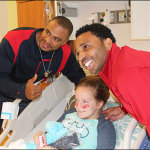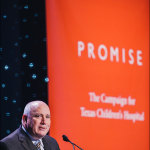
Dr. Jordan Orange, vice chair of research in the Department of Pediatrics, recently announced the winners of the 2015 Pediatric Pilot Awards Research Grant Program. Ten research applications were chosen by review committee members to receive grant funding in the amount of up to $50,000 for their projects.
The Pediatric Pilot Awards Research Grant Program provides initial start-up “seed funding” to support research projects. This grant program provides opportunities for new or less established researchers as well as experienced researchers who desire to expand their area of research. The grant projects are awarded based upon their scientific merit and the potential to generate the initial data necessary for a successful grant application submission to the National Institutes of Health or other external, peer-reviewed funding mechanisms.
The pilot award program is a collaborative effort between Texas Children’s Hospital and its academic partner, Baylor College of Medicine.
Congratulations to the following 2015 pilot grant awardees. Click on the name below to learn more about the research project being funded.
Ayse Arikan, M.D.
Pediatrics – Critical Care
The impact of renal support on nutritional deficiencies
Maria Bettini, Ph.D.
Pediatrics – Endocrinology and Metabolism
TCR parameters of CD4 T cell pathogenicity in Type 1 diabetes
Ashley Butler, Ph.D.
Pediatrics – Psychology
Pilot testing a novel intervention to improve nutritional intake among African American and Hispanic preschoolers by targeting parental stress and promoting mental well-being
Ivan Chinn, M.D.
Pediatrics – Immunology, Allergy and Rheumatology
An emerging paradigm: Novel primary immunodeficiency diseases caused by two-gene defects
Jimmy Holder, M.D., Ph.D.
Pediatrics – Neurology and Developmental Neuroscience
Pre-clinical studies of enzyme inhibition in an autism spectrum disorder
Philip Lupo, Ph.D.
Pediatrics – Hematology and Oncology
The metabolome and risk of pediatric acute lymphoblastic leukemia relapse
Shaine Morris, M.D., MPH
Pediatrics – Cardiology
The use of maternal hyperoxygenation in fetal left heart hypoplasia as a therapeutic and diagnostic method
Swati Naik, M.D.
Pediatrics – Hematology and Oncology
Functional monitoring of cellular immune responses post-transplant
Stephanie Sisley, M.D.
Pediatrics – Nutrition
Vitamin D receptor-mediated weight regulation: the importance of the brain
Pilar Ustero, M.D.
Pediatrics – Retrovirology
Evaluation of next generation TB testing in HIV-infected children and adolescents
Copy for individual blurbs:
 Ayse Akcan Arikan, M.D.
Ayse Akcan Arikan, M.D.
Pediatrics – Critical Care
The impact of renal support modality on nutrition
Critically ill children with acute kidney injury (AKI) do not get adequate nutrition in the intensive care unit (ICU). As protein and amino acids are essential for adequate healing and recovery, the ability to give sufficient protein nutrition depends on determining the exact amino acid profile in children with AKI. Yet, our knowledge in this area is very limited.
The sickest children with the most severe kidney disease need dialysis in the ICU. While life-saving, dialysis itself can cause protein and mineral (especially calcium and phosphorus) deficiencies. Kidney failure in the ICU can be reversible if the right treatment can be provided. However, if not managed correctly, it could also lead to irreversible kidney failure.
We know that protein malnutrition and mineral deficiencies are linked to higher chances of death in children receiving chronic dialysis for irreversible kidney failure. How these same deficiencies affect critically ill children and their chances of recovery from kidney failure are unknown.
Through our proposal, we want to find out what amino acids are deficient in children with AKI in the ICU. We also want to measure the amino acid and mineral losses that take place with dialysis. By increasing our understanding of nutritional imbalances that exit in AKI in the ICU, we hope to be able to provide better nutrition and increase chances of recovery and healing in critically ill children.
Information gained from the proposed study will improve our understanding of the perturbations in amino acid, mineral and micronutrient levels induced by AKI in critically ill children.
Furthermore, quantification of nutritional losses in the spent dialysis effluent coupled with this new knowledge will provide us with the ability to better ‘personalize’ the nutrition prescription, and potentially improve the outcomes of critically ill children on renal support, through appropriate protein, micronutrient, and vitamin D supplementation.
Reported studies on AKI to date have largely been descriptive and no other treatment other that dialysis exists for critical illness associated AKI. Our pilot project represents a unique nutritional “outside-the-box” approach to care of critically ill children with AKI.
 Maria Bettini, Ph.D.
Maria Bettini, Ph.D.
Assistant Professor, Pediatrics – Diabetes and Endocrinology
TCR parameters of CD4 T cell pathogenicity and tolerance in type 1 diabetes
T cells are a critical component of the immune system and possess highly variable T cell receptors, which are necessary for specific recognition of pathogens and long-lasting pathogen specific immunity. However, in the case of type 1 diabetes, T cells specifically target insulin producing beta cells in the pancreas. These autoimmune T cells express a variety of T cell receptors specific for beta cell proteins.
Our research focuses on trying to understand how T cell receptors guide T cell decisions in autoimmunity, which T cell receptors are the major contributors to tissue destruction, and whether we can find approaches to regulate self-reactive T cells. Our previous work has shown that not all beta cell reactive T cell receptors are the same, and some are more easily regulated than others. Because of this diversity, we hypothesize that a combination of different approaches or treatments is necessary to regulate or tolerize all T cells that are causing type 1 diabetes.
In the current proposed study, we will use cutting edge approaches to isolate multiple T cell receptor genes from the affected organ, test their function and ability to induce spontaneous diabetes in animal models, and assess their responses to immunotherapies. The results of this project will lead to identification of optimal tolerance induction protocols utilized for the abrogation of autoimmune responses by targeting T cells with a functionally diverse T cell receptor repertoire.
 Ashley Butler, Ph.D.
Ashley Butler, Ph.D.
Assistant Professor, Pediatrics – Psychology
Pilot testing a novel intervention to improve nutritional intake among African American and Hispanic preschoolers by targeting parental stress and promoting mental well-being
The high prevalence of obesity among minority children is a prime target for improvement to decrease racial and ethnic disparities in a host of short- and long-term health outcomes. Among preschool-age children, the prevalence of obesity is 17 percent and 11 percent for Latinos and African Americans, respectively, compared to 4 percent for non-Hispanic whites.
Establishing healthy dietary patterns in preschoolers represent a promising approach to prevent obesity since dietary patterns are established during the preschool-age years and preschoolers’ dietary patterns predict obesity during later school-age years. However, interventions have demonstrated only modest improvements in dietary patterns among minority preschoolers. A limitation of interventions includes failure to target central risk factors for poor dietary patterns among vulnerable minority young children.
High and chronic stress in minority parents that is linked to greater social and environmental stressors of chronic poverty, low socioeconomic status, and discrimination is increasingly recognized as a key contributor to poorer dietary patterns in minority children. Yet, no studies have targeted stress in parents to improve dietary patterns in young minority children.
This project will use a randomized-controlled pilot feasibility trial to examine preliminary dietary pattern outcomes of a modified version of a valid parent-based intervention (Smart and Secure Children Program) that was originally developed to improve child mental health. The program aims to target stress in parents, promote better parental mental health, increase knowledge about children’s development, and encourage positive effective parenting practices. Besides examining preliminary dietary pattern outcomes, this study will also examine the following secondary preliminary outcomes in parents: perceived stress, a stress biomarker, mental health and feeding behaviors.
This line of research will have important implications for identifying measures of stress that are amenable to intervention and for determining the degree to which parental stress is a key modifiable mechanism that should be targeted in interventions to decrease disparities in obesity prevalence among minority children.
 Ivan Chinn, M.D.
Ivan Chinn, M.D.
Pediatrics – Immunology, Allergy and Rheumatology
An emerging paradigm: Novel primary immunodeficiency diseases caused by two-gene defects
Children with primary immunodeficiency diseases are born with defects in the immune system that are caused by errors in the genetic code. For the past four decades, most research efforts have focused on trying to identify mutations in single genes that cause these diseases. We have found, however, that primary immunodeficiency diseases can be caused by mutations in two different genes. In fact, we believe that at least 5 percent of patients with primary immunodeficiency diseases who have a mutation in one gene actually possess a mutation in a second gene related to immune function that also contributes to their disease.
We will use new genomic technology, whole exome sequencing (DNA sequencing of all of the genes in a person that encode proteins) to identify patients with primary immunodeficiency diseases who have two or more deleterious alterations in genes important for immune function. This work is performed in collaboration with the world-recognized Baylor College of Medicine Center for Mendelian Genomics, which has continuously led the field in developing and applying the use of whole exome sequencing for clinical and research purposes.
We will also take advantage of the cutting-edge technology available in the Texas Children’s Hospital Center for Human Immunobiology to perform cellular and molecular studies in genetically modified cells to determine the biological relevance of two-gene defect combinations in patients with primary immunodeficiency diseases.
This pilot award will allow us to directly address our lack of knowledge concerning the genetic prevalence and potential mechanisms of two-gene defects in children with primary immunodeficiency diseases. Ultimately, we expect this research to strongly challenge others to expand the way that they currently diagnose patients with these diseases to encourage them to systematically assess for multiple-gene defects. Thus, our work will not only advance our scientific knowledge but also improve our ability to recognize and appropriately treat patients who are born with defects in the immune system.
 Jimmy Holder, M.D.
Jimmy Holder, M.D.
Pediatrics, Neurology and Developmental Neuroscience
Preclinical studies of enzyme inhibition in an autism spectrum disorder
Autism is a common neurodevelopmental disorder affecting more than one in 100 children. Currently, there are no effective therapies to treat the primary symptoms of autism which include abnormal language development, socialization and restricted interests. This is largely due to our incomplete understanding of the neurobiological basis of autism.
Mutations of a gene called SHANK3 are one of the more common genetic causes of syndromic autism. In addition to the core symptoms of autism, children with mutations in SHANK3 have moderate to severe intellectual disability and often intractable epilepsy.
In the first year of this award, we performed a screen to identify proteins that regulate the abundance of SHANK3. We identified a pathway of kinases that regulate SHANK3 abundance in cell lines and primary neurons. In this second year, we will determine if this same kinase pathway can regulate SHANK3 abundance in mice and if inhibiting this pathway can rescue behavioral and molecular deficits in mice with SHANK3 deficiency. This work will potentially set the stage for clinical trials of targeted therapies in individuals with SHANK3 mutations.
 Philip Lupo, Ph.D.
Philip Lupo, Ph.D.
Pediatrics – Hematology and Oncology
The metabolome and risk of pediatric acute lymphoblastic leukemia relapse
Innovative approaches are needed to predict and target relapsed acute lymphoblastic leukemia (ALL) in children. Despite advances in ALL treatment, approximately 20 percent of children will suffer relapsed disease. Outcomes with salvage therapy are disappointing, with only 35 percent of children surviving after disease recurrence. In fact, given the number of ALL cases each year, relapsed ALL accounts for more deaths from cancer in children than any other malignancy.
As metabolites change rapidly in response to chemotherapy, the newly emerging field of metabolomics holds great promise for predicting response to cancer therapy. Our long-term goal is to identify novel biomarkers of ALL relapse in order to improve outcomes for those with relapsed disease. The objective of this pilot project is to determine the utility of global metabolomic profiling for predicting relapse among children with ALL.
This study represents an important step toward understanding the biology of relapsed ALL and identifying biomarkers that may be useful in improved risk stratification strategies. Finally, the discovery of metabolites associated with increased risk of relapse may allow us to better target chemo-resistant disease, which ultimately may point to enhanced frontline therapies.
 Shaine Morris, M.D., MPH
Shaine Morris, M.D., MPH
Pediatrics, Cardiology
Maternal Oxygen Therapy for Fetal Left Heart Hypoplasia
Heart disease is the leading cause of infant death related to birth defects. Congenital heart disease in which the left sided structures of the heart (left heart hypoplasia or LHH) are too small are among the most severe, and have some of the highest death and other complication rates. One of the associated significant complications of LHH is immaturity of the brain at birth.
We intend to study a new, non-invasive fetal intervention to improve outcomes in children with LHH. We plan to perform a pilot randomized controlled trial to study the effect of giving inhaled, supplemental oxygen to mothers who have fetuses with small left-sided structures. We specifically will evaluate whether providing mothers with extra oxygen throughout pregnancy will result in improved growth of fetal left heart valves and if it would result in improved brain maturation.
After enrollment, mothers will be randomly assigned to either oxygen or placebo treatment (regular air), but neither the doctors nor the mothers will know which treatment they are receiving. All enrolled mothers will be asked to receive their assigned treatment continuously for the rest of the pregnancy using a nosepiece (nasal cannula). At birth, we will compare the fetuses whose mothers received oxygen to those receiving placebo. We specifically will study the size of the left heart valves using echocardiography and brain maturation using magnetic resonance imaging.
 Swati Naik, M.D.
Swati Naik, M.D.
Pediatrics – Hematology and Oncology
Functional monitoring of cellular immune responses post-transplant
Hematopoietic stem cell transplantation (HSCT), which involves replacing a patient’s blood and immune system with that of a healthy donor, is the preferred treatment for several childhood cancers and blood disorders. However, it often takes several months for the patient’s immune system to return to normal after the procedure and during this time these patients are highly susceptible to potentially life-threatening viral infections.
In this study, we will measure the speed of immune recovery in patients to better identify those at greatest risk of developing an infection. Furthermore, in these patients we will evaluate the benefit of administering special immune cells called virus-specific T cells (VSTs) that were specially trained in the lab to learn how to fight infections. The goal of this study is to evaluate immune recovery in patients undergoing transplant and use this information to identify patients that could benefit from treatment with VST therapy.
 Stephanie Sisley, M.D.
Stephanie Sisley, M.D.
Pediatrics – Nutrition
Vitamin D Receptor-mediated weight regulation: the importance of the brain
Obesity is prevalent in one third of American adults and children and costs the American health care system billions of dollars yearly. There are strong associations of low vitamin D levels with obesity, yet an underlying causal relationship has not been identified.
Multiple clinical trials have been performed to use vitamin D as a treatment for obesity with conflicting results. The extensive impact of obesity on patients and its cost to society make the establishment of effective treatments urgently necessary. However, treating obesity and decreasing its prevalence cannot occur until we understand the mechanisms underlying the onset and progression of obesity.
One of the possible mechanisms linking obesity and low vitamin D levels is through the brain. Accumulating evidence indicates that the brain has receptors for vitamin D in key weight regulatory regions. However, the potential brain regulation of weight by the vitamin D receptor has not been studied.
Our long-term research objective is to unravel the vitamin D-dependent mechanisms underpinning childhood obesity and to translate these findings into new therapeutic options for the pediatric population. Our preliminary data reveals the ability of the active ligand for the vitamin D receptor, 1,25-dihydroxyvitamin D3 (calcitriol) to dramatically reduce food intake, body weight, and fat mass in obese rodents when delivered directly into the brain.
Using genetic approaches, this award will enable us to dissect the role of specific neuronal population on the effects of vitamin D in the brain on weight regulation. These findings may lead to a new pathway for weight regulation and thus possible new therapeutic avenues for the obese population.
Pilar Ustero Alonso, M.D.
Assistant Professor, Pediatrics – Retrovirology
Evaluation of next generation TB testing in HIV-infected children and adolescents
Following infection with Mycobacterium tuberculosis (M.tb), the 5-year risk of tuberculosis (TB) is 33 percent in children under 5 years and 20 percent for 5-14 years of age. TB risk is greatest in the year following infection and highest among young, malnourished and immune-compromised children; up to 50 percent of children infected during the first year of life develop disease in the absence of preventive therapy (PT). In Swaziland, with a TB incidence of 703 cases per 100,000 population, children are at high risk of becoming infected and developing TB.
While M.tb infection is routinely diagnosed in developed countries, the use of Interferon gamma release assays (IGRA) is limited in high TB burden countries due to financial constraints and limited evidence regarding utility in HIV-infected population, particularly in the presence of severe immunosuppression), as the assay measures the CD4+ T lymphocytes response.
Through this Pilot Award Grant we are studying a new prototype test which includes a set of peptide antigens designed specifically to stimulate M.tb-specific CD8+ T lymphocytes, in addition to existing CD4+ T lymphocytes stimulating peptides. This new test might therefore further increase the sensitivity of the assay and in particular increase the utility of the test in children co-infected with HIV. Furthermore, the ability to uniquely measure the CD8+ and CD4+ Tcell responses provide an important opportunity to study the effects on HIV immune suppression on the TB specific immune response in children and determine if the predominant phenotypic response is associated with TB disease and infection states.












































